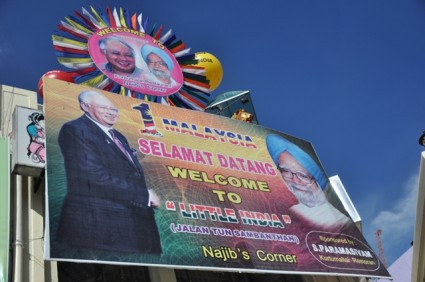Brickfields is one of those KL (Kuala Lumpur) neighbourhoods lately marketed under a “Little India” label. Centrally-located and generally lively all day and night, it has transformed over the past decade or so in to a hub of Indian-ness, both ‘foreign’ and ‘local’. This Indian feel has become so pronounced that in 2010, Brickfields’ main drag, Jalan Tun Sambanthan, was even lined with Indian-styled structures after an extensive redevelopment.
Located in the narrowly-won and hotly-contested seat of Lembah Pantai, where Pakatan Rakyat (PR) incumbent Nurul Izzah Anwar is up against Barisan Nasional’s (BN) Raja Nong Chik, Brickfields is an important location in the contest for this weekend’s election. On Saturday night it hosted a PR ceramah (political speech/talk) with Nurul Izzah. Around a week ago, it was the site for the signing of an MoU under which Barisan Nasional was assured the support of HINDRAF, the Hindu Rights Action Force. Perhaps tired from all this action, last night Brickfields may have been taking a break. As I rolled in, fresh off the plane, Jalan Tun Sambanthan was dead.
Granted, it was a bit late. Yet it was early enough that all the makan places (restaurants and/or hawker stalls) and sari shops were open. The street was lined with blue and white BN bunting. At one end of the street, there was a BN stall staffed by a lone volunteer, who no-one talked to the entire time I was out hanging around. A large banner festooned one street corner, which it declared the Little India Najib Corner. A few cars passed, a few people sat with cups of tea, a Tamil film played from a shop TV. Eerily quiet, Brickfields had the look and feel of a newly-pacified territory.
So why were there no shoppers and no eaters? Is it because the 2010 Little India development involved sanitising the streetscape almost beyond recognition? Packed with office buildings, hotels, and useful but ugly rail infrastructure, Brickfields is a concrete jungle, and it seems hotter every year. Only the back streets are still cool and lively, and in all honesty there are better eats to be had there anyway.
So why develop the main street in this way? For the same strategic and optical reason BN signed the HINDRAF MoU here. In the lead-up to the 2008 election, HINDRAF had catalysed the slow collapse of Indian voter support for BN. The Little India streetscape was one BN response to this new electoral reality, and, naturally, the co-option of HINDRAF by MoU was another. Once led by two brothers, HINDRAF is now split and neutralised. One brother, P Waythamoorthy now claims to support BN; while the other, P. Uthayakumar, faces impending arrest under sedition charges.
Dr Amrita Malhi is a Research Fellow in the Hawke Research Institute at the University of South Australia. She is working on a monograph on the production of ‘Muslim’ as an anti-colonial identity in a 1920s uprising in Malaya; supported by an Social Science Research Council postdoctoral fellowship in transnational research, with funds from the Andrew W. Mellon Foundation. Her PhD was awarded the 2010 J.G. Crawford Prize at the Australian National University.
 Facebook
Facebook  Twitter
Twitter  Soundcloud
Soundcloud  Youtube
Youtube  Rss
Rss 